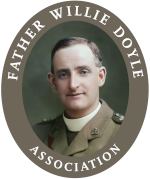In advance of this evening’s programme on Irish television about Fr Frank Browne’s heroic service in the First World War, I have invited Carole Hope to contribute a guest post on Fr Doyle and Fr Browne’s relationship. Carole is a military historian who has written a new biography of Fr Doyle entitled Worshipper and Worshipped. This excellent book is the definitive guide to Fr Doyle’s military career, and can be bought here.
Here is Carole’s post:
Fr Frank Browne was a Jesuit priest who served as a military chaplain during World War One and was awarded the Military Cross and Bar (i.e. second MC). He was a colleague and friend of Fr Willie Doyle for nearly eight months between December 1916 and August 1917, when they both had spiritual charge of battalions of the Royal Dublin Fusiliers.
Fr Frank Browne is well known for his Titanic connection and unique collection of photographs he took before disembarking at Cobh. The documentary tonight seeks to redress the balance between the fame of a few days compared to three years during which time he also photographed his surroundings on the Western Front. The name Fr Frank Browne is fairly well known within the WW1 interest community, but invariably it is associated with his service with the Irish Guards. His service with Royal Dublin Fusiliers, alongside Fr Doyle, is often overlooked, yet he was awarded his first Military Cross for actions with the Royal Dublin Fusiliers.
Whilst researching my book, Worshipper and Worshipped, about Fr Willie Doyle, I looked at the War Office files for both priests held at the National Archives in Kew, south-west London. Fr Frank Browne signed a contract for duty as temporary Chaplain to the Forces on 17th February 1916 and was appointed for duty with the Irish Guards. Seven months later, in September, he was struck in the lower face by a piece of shell casing, which was surgically removed but he endured post-operative problems of an abscess, difficulties in opening his mouth and could only take soft foodstuffs. His personal file notes that the wound was very severe. His period of convalescence lasted until the middle of December 1916, when he reported for further duty and embarked at Folkestone on 19th, finding himself attached to Fr Willie Doyle’s 48th Infantry Brigade in the Messines area of Belgium south of Ypres.
Like any large organisation an army is made up of many components, of which an Infantry Brigade is one and likewise an Infantry Brigade consisted (at that time) of four smaller units i.e. battalions. Fr Doyle already had spiritual charge of two of the battalions of 48th Infantry Brigade, whilst Fr Browne arrived to take charge of the other two. Fr Browne’s first meeting with Fr Doyle was in a trench dug-out, when he came up with his battalions, 2nd and 9th Royal Dublin Fusiliers, who were relieving Fr Doyle’s 8th Royal Dublin Fusiliers and 7th Royal Irish Rifles.
The four battalions were rotated between front line trenches facing No-Man’s-Land, support trenches further back and then for periods of rest and training back further still away from the guns, where the men lived in hutted encampments and the chaplains had billets in the convent at Locre. Fr Browne and Fr Doyle and their flock also spent two periods of time in the peaceful region of Pas de Calais, for specialist training manoeuvres, and it is during the second period that they conducted a special service for some 2,000 Royal Dublin Fusiliers in St Omer Cathedral on 15th July 1917. This in itself is indicative of the closeness and effectiveness of their working relationship.
Between 23rd December 1916 and early August 1917 Fr Browne and Fr Doyle formed a close friendship as well as working relationship, which is clearly evident from personal letters written by both priests. The Remembering Fr Doyle Blog has quoted from them many times, but the following quote from Fr Browne bears repeating and sums up both their personal relationship and their dedication to duty:
“During our whole time there we relieved each other in this way every eight days. I remember how decent Fr. Willie used to be, coming up early on the relief days, before his Battalion came up, in order that I might get away. He knew how I hated it – and I did not hate it half as much as he did. We used generally to confess to each other before leaving. We were very exact about waiting for each other, so that I do not think the (48th) Brigade was ever without a priest in the line.”
Fr Browne was transferred back to the Irish Guards early in August 1917, just prior to the start of another offensive during the Battle of Third Ypres. The Irish Guards were going out of the line, having been part of the first attack of 31st July, whilst the Royal Dublin Fusiliers were to attack on 16th August. There was no one to replace Fr Browne and he was so concerned about the foul conditions in which the Royal Dublin Fusiliers had to work in, and the fact that Fr Doyle had to cover all four battalions, that he managed to get back to Ypres to visit on 15th August 1917. He shared the vast outpouring of grief at the news of Fr Doyle’s death on 16th August, which is recorded in several of his letters.
Fr Browne saw out the war with the Irish Guards, being wounded at least one more time, as well as being awarded another Military Cross. I doubt if he forged a closer relationship with any other colleague than Fr Doyle.


[…] You can read about Fr Browne’s military service here. […]